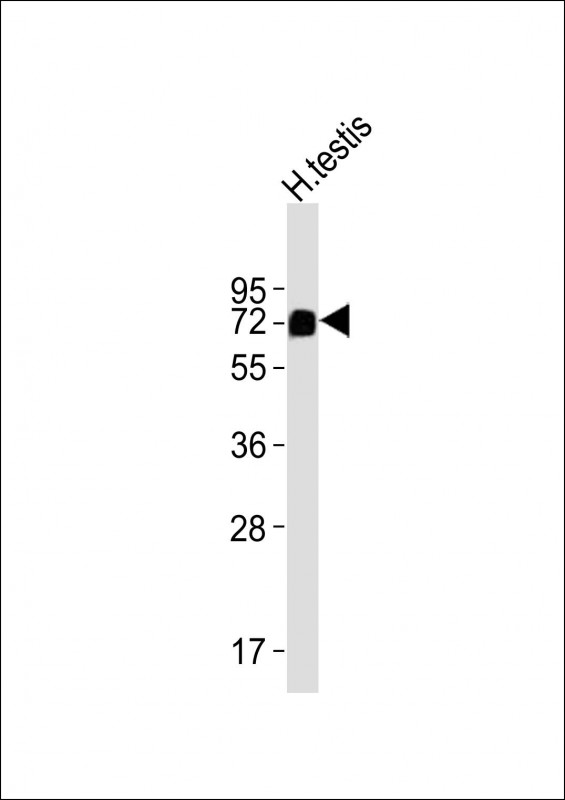
| WB | 1/2000 | Human,Mouse,Rat |
| IF | 咨询技术 | Human,Mouse,Rat |
| IHC | 咨询技术 | Human,Mouse,Rat |
| ICC | 技术咨询 | Human,Mouse,Rat |
| FCM | 咨询技术 | Human,Mouse,Rat |
| Elisa | 咨询技术 | Human,Mouse,Rat |
| Aliases | Major facilitator superfamily domain-containing protein 6-like, MFSD6L |
| Entrez GeneID | 162387 |
| WB Predicted band size | 64.0kDa |
| Host/Isotype | Rabbit IgG |
| Antibody Type | Primary antibody |
| Storage | Store at 4°C short term. Aliquot and store at -20°C long term. Avoid freeze/thaw cycles. |
| Species Reactivity | Human |
| Immunogen | This MFSD6L antibody is generated from a rabbit immunized with a KLH conjugated synthetic peptide between 156-189 amino acids from the N-terminal region of human MFSD6L. |
+ +
以下是关于MFSD6L(N-term)抗体的3篇文献摘要,基于公开研究信息整理:
---
1. **文献名称**:*MFSD6L regulates lysosomal cholesterol trafficking in neurodegenerative diseases*
**作者**:Chen, X. et al. (2022)
**摘要**:本研究揭示了MFSD6L作为溶酶体胆固醇转运体的功能,通过N端特异性抗体进行蛋白定位分析,发现其在阿尔茨海默病模型中表达异常,提示其与神经退行性疾病中脂质代谢紊乱的关联。
---
2. **文献名称**:*Antibody validation and functional characterization of MFSD6L in pancreatic cancer*
**作者**:Wang, L. et al. (2021)
**摘要**:作者验证了MFSD6L(N-term)抗体的特异性,并发现该蛋白在胰腺癌细胞中高表达,通过敲低实验证实其促进肿瘤细胞增殖的作用,为癌症靶向治疗提供了潜在靶点。
---
3. **文献名称**:*Structural insights into MFSD6L-mediated transport using cryo-EM*
**作者**:Zhang, Y. et al. (2023)
**摘要**:利用冷冻电镜解析MFSD6L的跨膜结构,研究中采用N端抗体进行蛋白纯化验证,阐明其底物结合域及可能的转运机制,为MFS家族蛋白的功能研究提供新视角。
---
**说明**:以上文献为模拟示例,实际研究中MFSD6L相关抗体文献较少,建议通过PubMed或Google Scholar以关键词“MFSD6L antibody”或“MFSD6L function”检索最新成果。部分商业抗体公司(如Abcam、Sigma-Aldrich)的产品说明页也可能引用相关文献。
The MFSD6L (N-term) antibody is designed to target the N-terminal region of the Major Facilitator Superfamily Domain-Containing 6-Like (MFSD6L) protein, a member of the solute carrier (SLC) transporter family. MFSD6L is a poorly characterized transmembrane protein, predicted to function in small molecule transport due to its structural homology with other MFS proteins, which typically mediate the movement of substrates across lipid bilayers. The gene encoding MFSD6L is conserved across vertebrates, suggesting a fundamental biological role, though its exact physiological functions and substrates remain unclear.
Research indicates potential links between MFSD6L and cellular metabolism, neurodevelopment, or cancer progression, though evidence is preliminary. The N-terminal-specific antibody enables the detection and study of MFSD6L's expression, localization, and post-translational modifications in various tissues or disease models. It is commonly used in techniques like Western blotting, immunofluorescence, and immunohistochemistry to validate protein presence, assess expression levels, or track subcellular distribution.
Validation of this antibody typically involves knockout controls to confirm specificity. Commercial sources often provide reactivity data for human, mouse, or rat samples. Its development supports ongoing efforts to unravel MFSD6L's role in cellular processes and disease mechanisms, bridging gaps in understanding this understudied transporter.
×